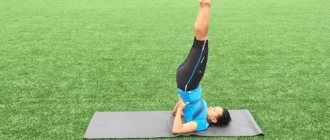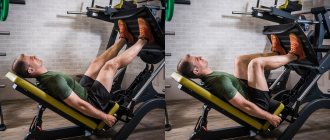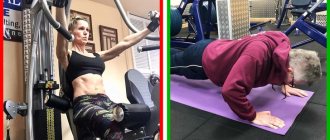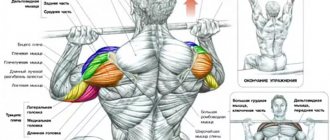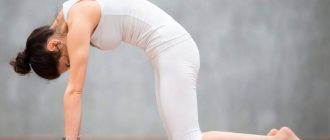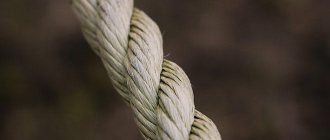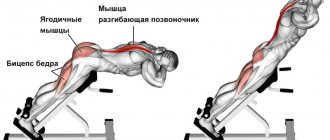How to do the wall leg raise exercise correctly
Start by creating a cozy space near the wall. Lay out a mat and sit comfortably on it.
Then move your hips as close to the wall as possible.
After this, you should raise your legs along the wall. Raise your legs until your body is in an L shape.
Make any changes to make you feel comfortable. For example, place a pillow under your head or place your hands on your stomach.
Juicy, bright and unusual orange coloring: 10 spectacular ideas
Shoes chosen by women with good taste: trending models for 2022
If there is only one chicken at home: roll up 5 cans of juicy stew (enough for a long time)
Focus on your breathing. Take a deep, slow breath in through your nose and a deep, slow breath out through your nose.
Try to stay in this pose for at least 10-15 minutes for optimal results.
How to include a glute bridge in your workout?
If the workout begins with complex exercises such as squats or deadlifts, then it is better to do the bridge closer to the end of the fitness lesson.
“If the feet are positioned correctly, this is an isolated exercise,” says Anastasia Simanova. “As a rule, I finish my workout with it.” This is how I finally “score” my buttocks.”
But this is not a strict rule. “You can do a glute bridge at any time during training,” says Asya Alexandrova. - It is most effective to do it in a set of squats or lunges. In general, your sports trainer will advise you when to start this exercise, since it all depends on your training plan.”
Advantages
Legs Up the Wall exercise has many health benefits:
- Relaxes the mind and body. This exercise is a great way to calm your nerves and improve your well-being. You will be able to deeply relax, get rid of anxiety and tension, and restore peace of mind.
- Improves blood circulation. This pose helps relieve swelling in the legs and feet by eliminating the effects of gravity on the lower body. Exercise also facilitates venous drainage and improves the movement of lymphatic fluid in people with low blood pressure or who spend a lot of time standing during the day.
- Eliminates muscle spasms. This is one of the best ways to relieve tension and spasms in the legs and feet. This can be a good therapeutic technique after a flight or physical activity. The exercise can help relax the pelvic floor. It can relieve menstrual cramps and related problems (pains of various localizations).
- Helps stretch the hamstrings and glutes. The pose gently stretches the hamstrings, glutes, spine and hips, relieving stress on the lower back. In addition, the angle of the body in this pose reduces the curvature of the lumbar spine, which leads to stretching of the back muscles. The closer your hips are to the wall, the more the hamstrings are stretched.
- Relieves tension in the lower back. The exercise relieves pressure and tension in the lumbar region and also relaxes the muscles in this part of the body. Pressure is relieved from the spine by lying on your back. The pose gently stretches the hamstrings and the back of the neck, relieving back pain.
- Relieves headaches and migraines. Since most headaches are usually related to tension, the pose helps to gently stretch and relax the muscles of the neck, shoulders and back, improving blood circulation in the head.
- Improves digestion. When you combine holding your legs in this position for a long time with slow and rhythmic breathing, you activate the digestion process.
- Improves sleep. The position of the legs in the exercise, combined with controlled breathing, lowers the heart rate, which triggers a relaxation response and helps reduce anxiety, stress and insomnia. This pose is ideal as a preparation for bed if you suffer from insomnia.
- Helps calm thoughts. By completely relaxing your body and focusing on deep breathing, you will induce a meditative state.
- Gives all the benefits of inversion without the effort. Exercise can help increase energy levels, balance blood pressure and relieve pain. Although this pose requires much less physical effort, you will still get many benefits from doing it.
Glute bridge: what muscles work?
The advantage of the exercise is that it can be used to train the buttocks, avoiding excessive growth of the quadriceps (front thighs), which always scares girls. The exercise involves the strength of the following muscles (we list them by decreasing the load on them):
- gluteus maximus muscle;
- gluteus medius muscle;
- press;
- gluteus minimus;
- biceps femoris (biceps femoris), located on the back of the thigh;
- deep core muscles;
- spinal extensor muscles;
- calf muscles.
- deep work of the gluteal muscles;
- strengthening the abdominal muscles;
- strengthening the pelvic floor;
- minimal load on the knee joints;
- the ability to perform at home;
- the ability to independently regulate the load.
Consequently, the muscles of the anterior thigh (quadriceps) are excluded from the work; it is performed mainly by the gluteus maximus muscle.
For what diseases is exercise with raising legs against a wall useful?
Restorative yoga poses, including this exercise, are beneficial for those who have the following health problems:
33 galleries, shops and restaurants: a museum is being completed in Hong Kong
“This is my stepmother”: Semyon Treskunov told and revealed a family secret
This dog adopted four furry babies as his own, and it doesn’t matter that they are kittens
- fibromyalgia;
- venous diseases (for example, varicose veins);
- complications during menopause (for example, you experience hot flashes);
- restless legs syndrome;
- metabolic syndrome.
Is low blood pressure dangerous?
Many people - most often thin women - live with hypotension for years and feel great. Doctors believe that these people are lucky: they are less likely to suffer from cardiovascular diseases.
However, if your blood pressure suddenly drops below normal levels, unpleasant symptoms may appear:
- blurred vision;
- dizziness;
- fainting;
- nausea or vomiting;
- drowsiness;
- feeling of weakness.
As a rule, at a young age, the health risk is associated not with low blood pressure itself, but with the reasons due to which it falls. The exception is fainting. “This is the most alarming symptom, since it often leads to injuries and accidents,” says Oksana Dikur, general practitioner, cardiologist at the Rassvet clinic. “If hypotension is accompanied by loss of consciousness, you should definitely consult a doctor.”
But for older people, low blood pressure can be really dangerous. Moreover, a drop in diastolic pressure is more dangerous than a decrease in systolic pressure.
“This can lead to deterioration of blood supply to the kidneys and brain, increasing the risk of stroke and kidney failure,” explains Oksana Dikur.
General Tips
For best results when performing the exercise, try not to tilt your torso at an absolute 90-degree angle, as this can impede blood circulation in the thighs. Instead, move your hips a few inches away from the wall or raise them slightly by placing a pillow under your sacrum.
You may experience tingling or numbness in your legs or lower back while doing the exercise. In this case, shake your legs to stimulate blood circulation.
Take care of your feet
Let's work from a standing position again. Raise your heels off the floor 1 cm, and then lower yourself to the floor. You should feel a slight shaking, similar to when walking or running. Perform the exercise fairly firmly, but not too harshly. Movements should not be painful in the lower back!
Do such blows once a second, not more often. After 30 lifts, be sure to give yourself a break of about 10 seconds. It is not recommended to do more than 60 “concussions” in one approach.
This movement will give the blood a good impulse to rise up the legs from bottom to top.
Fitness while walking. We train leg muscles Read more
Exercise "Butterfly"
There are several variations of the pose with legs raised against the wall. One of them is the “Butterfly” exercise. As you do this, you will be able to feel the stretch in your inner thighs. Algorithm of actions:
- Position the soles of your feet so that they touch each other and your knees point outward to the left and right.
- Bend your knees and slowly move your feet toward your hips along the wall.
- You can intensify the stretch by gently pressing your knees against the wall.
You can also place a bolster under your hips to lift them and create a slight inversion in your lower abdomen. You can also use a strap to hold your legs together so you can fully relax without any extra effort.
Found a violation? Report content
What are the benefits of a glute bridge?
As we have already explained, in this exercise the glutes do the main work, and are not used as auxiliary muscles, as is the case in squats, deadlifts and often even lunges, although the latter are considered the best exercises for the buttocks.
Deadlifts, squats, lunges are exercises where movement occurs in the hip joint and knee. In different versions, you can shift the emphasis either to the gluteal muscles or to the back of the thigh. Moreover, in squats, for example, noticeable activation of the gluteal muscles occurs only with a sufficiently high weight - 80-85% of the maximum. The benefit of the gluteal bridge is that it safely and even without weights loads the buttocks and back of the thigh, which are often a problem area for girls.
Thus, the glute bridge and squats and lunges are not interchangeable, but rather complement each other. In terms of biomechanics, the shoulder bridge is more similar to hyperextension (extension of the body while lying on your stomach in a machine) and deadlift on straight legs.
“With the correct positioning of the legs, this is an isolated exercise specifically for the buttocks,” says Anastasia Simanova. — If you use weight sufficient for muscle growth (barbell, dumbbell, plate), you can increase lean body mass. The exercise engages muscles that are often turned off even in some athletes, not to mention the average person - the rotators of the lower extremities. The result makes your posture and gait more correct.”
